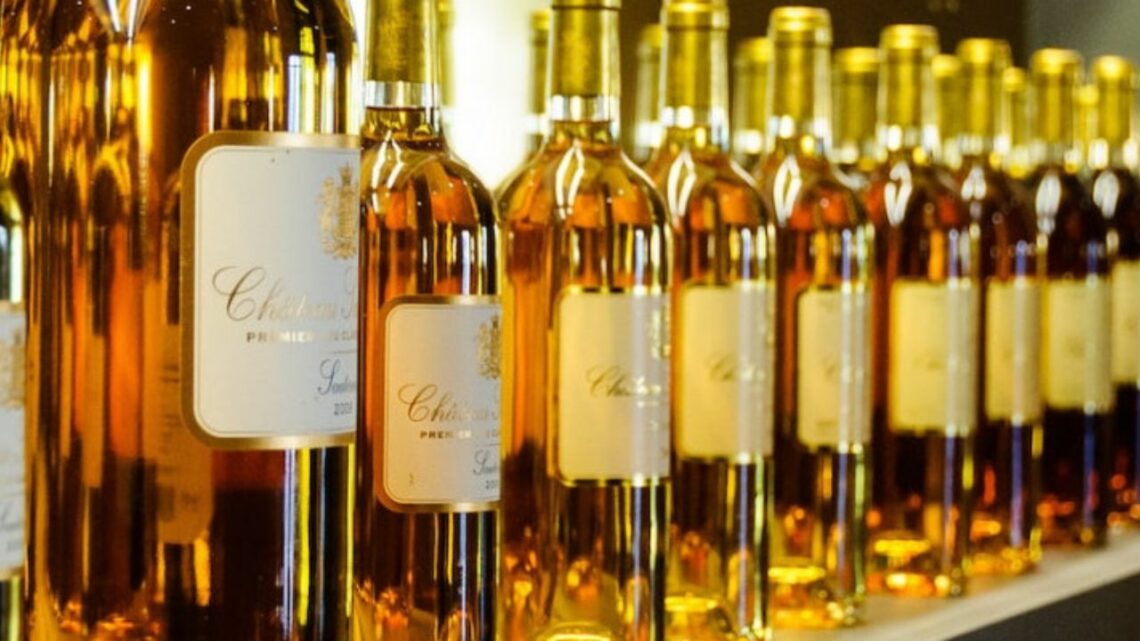
How would you compare Sauternes wine to ice wine from Canada?
Sauternes and Ice wine are both sweet white wines. The former comes from Bordeaux, in the sub region Graves. The latter is made in Germany and Austria mostly but also in Canada.
Are they similar? How could you compare Sauternes wine to ice wine from Canada?
Let’s start by defining each type and compare them afterwards.
What is Sauternes wine?
The great sweet wines of Bordeaux, Sauternes (or Barsac) are made from grapes affected by noble rot. The best are fermented and aged for up to three years in new barrels.
Sauternes wines are usually a blend of Sémillon and Sauvignon Blanc.
Semillon is the most common grape variety for sweet wines because of the finesse of its skin and its affinity for noble rot. These grapes have medium to high acidity and bring aromas of dried fruit, nuts and honey.
Sauvignon Blanc brings the acidity to the blend.
Muscadelle is sometimes added to the blend, in small proportion. It is characterized by marked aromas of fresh grapes and flowers.
These wines have distinctive notes of honey, apricot, citrus zest and dried fruit.
What is noble rot? Noble rot is caused by a fungus, Botrytis cinerea, which is also the cause of gray rot. Specific conditions are indeed necessary for the appearance of noble rot. First of all, the grapes must be perfectly ripe before the fungus develops. Then the vines should be in a foggy and humid region in the morning, then sunny and dry in the afternoon.
Indeed, the morning humidity allows the development of rot on the berries. The microscopic filaments of the fungus pierce their film, forming tiny holes. The warm, sunny afternoon weather then slows down the development of the fungus while causing the water in the grapes to evaporate, concentrating acids, flavors and sugars. Botrytis also gives rise to new aromas that are specific to it.
What is ice wine from Canada?
Canadian vineyards are subject to a harsh continental climate, but one that is tempered by the influence of large bodies of water. Canada produces world-renowned ice wines.
These wines are usually made from Riesling. Vidal, a hybrid and robust grape variety is sometimes added to the blend. Vidal does not quite have the structuring acidity and aromatic complexity of Rieslings.
How is ice wine made? The grapes are left on one foot during the winter, so when frost comes, the water in the berries turns into ice. When the grapes are finally harvested and pressed, the ice remains in the press, which increases the sugar content of the juice thus obtained. This technique is used to produce eiswein in Germany and ice wine in Canada. These ice wines offer very pure primary aromas.
How would you compare Sauternes wine to ice wine from Canada?
Both wines are made differently. And of course, this has an impact on how they taste.
Ice wines usually have high levels of sweetness and lower acidity. They have less alcohol than Sauternes, 10% versus 13% in the Bordeaux wines.
These wines tend to feel thick on the palate, a bit like syrup for example. The primary aromas will stick out so these wines will taste of apples, pears, white flowers or even green melon.
I wouldn’t pair these wines with food but treat them as dessert altogether. You can try them with dry Italian biscuits for instance.
Wines from Sauternes tend to have honey, apricot, citrus zest and dried fruit aromas. Moreover, the medium to high acidity balances the sweetness in the wine making it silky but less thick on the palate. This balance, in the best years, reaches the bliss point.
These are wines that can be paired with food, such as foie gras, blue cheese, fruit tarts..or these famous Italian almonds biscuits.
One point that these wines have in common is their production price (which influences their price directly of course).
Ice wine needs to meet certain conditions in order to be made. For instance, the temperature must be below – 8°C. While the growers wait for the temperature to reach this threshold, animals tend to feast on the vines. This limits the yield (and increases the price)
In the Bordeaux region, the ideal conditions for noble rot are not met every year. If it is too humid, the fungus grows too quickly and causes gray rot, which causes the berries to burst and promote infections.
Thus, raisining is sometimes necessary to promote the concentration of sugars when botrytization is not enough.
What is raisining or passerillage? The berries how to dehydrate and turn into raisins on the vines, increasing the sugar concentration of the juice. For this, a warm and dry autumn is necessary, in order to avoid gray rot.
Conclusion : How would you compare Sauternes wine to ice wine from Canada?
Sauternes and Ice wine are both sweet white full-bodied wines. The former is a blend from Sémillion and Sauvignon, with a splash of Muscadelle, whereas the latter is made from Riesling and/or Vidal.
Both are difficult to produce because certain conditions must be met and this is no easy task.
However, seeing as the grapes and method of production differ, they are also very different in taste. Sauternes will have higher levels of acidity and alcohol, whereas Ice wine will have higher levels of sugar.
Ice wine will present primary aromas such as apple or white flowers, whereas Sauternes will be more complex and present aromas of dried fruits, nuts and honey.
Which one would you pick? Let me know in the comments!







